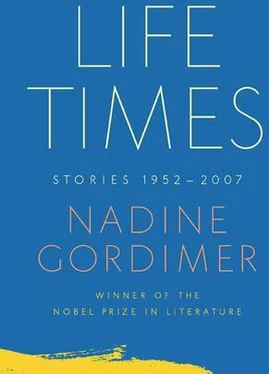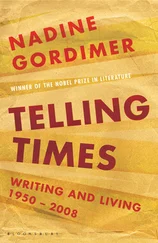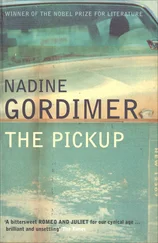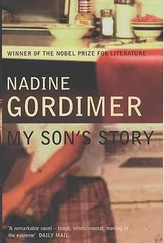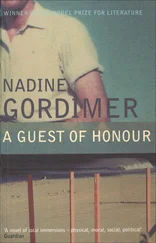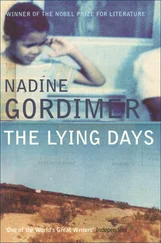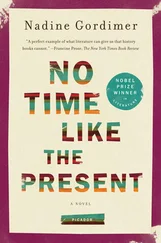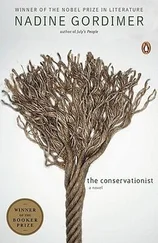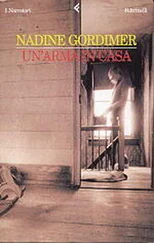Eddie got a lift with a black man in a firm’s panel van. They talked about soccer. He did not ask to be let down at the local dorp where Joy and Mrs Naas Klopper shopped. He went all the way — to Johannesburg.
Eddie had nothing to leave at the entrance to a supermarket where you were asked to deposit your briefcase or carrier bag in return for a numbered disc. He did not uncouple a trolley from the train against the wall, or pick up a plastic basket. He walked the lanes as if at a vast exhibition, passing arsenals of canned fruit, yellow mosaics of pickles in jars, flat, round and oval cans of pilchards, sardines, anchovies, mussels in brine and tuna in cottonseed oil, bottles of sauces, aerosol cans of chocolate topping, bins of coffee beans, packets of rice and lentils, sacks of mealie-meal and sugar, pausing now and then, as if to read the name of the artist: Genuine Papadums, Poivre Vert de Madagascar — and then passing on to pet and poultry foods, detergents, packaged meat like cross-sections of viscera under a microscope, pots, Irish Coffee glasses, can openers, electric pizza-makers, saws, chisels, light bulbs, roundabout stands of women’s pantyhose, and greeting cards humorous, religious or sentimental. White women pushed small children or small dogs in the upper rack of trolleys. Black people turned over the packages of stewing meat. Other blacks, employees, wielded punches that printed prices on stocks they were replenishing. The piped music was interrupted by chimes and a voice regularly welcoming him (in his capacity as a shopper) and announcing today’s specials. At the record and tape bar he spent half an hour turning over the decks of bright neat tapes the way others did meat packs. There were no facilities for listening to tapes or records, but he knew all the groups and individuals recorded, and their familiar music sealed within. A supermarket wouldn’t have anything that hadn’t been reissued in cheap mass pressings — you’d need a record shop for really good, new stuff. Going through these was just looking up what hadn’t changed.
He queued at one of the exits holding a set of transistor batteries and a snuffbox-sized tin of ointment he hadn’t seen since his mother used to put it on his sores as a kid. A mama ahead of him, turning to speak Setswana, at home here in this city in her slippers, outsize tweed skirt and nylon headscarf from some street-vendor’s selection, assumed his support, as one of her own, in an argument over change with the aloof almost-white cashier. From the stand beside him he took, as a tourist picks up a last postcard, one of the pairs of sunglasses hooked there.
In the streets there were thousands like him. He crossed at traffic lights and walked pavements among them. Young ones loping in loose gangs of three or four, out of work or out of school, going nowhere. When you are that age, the city, where there is nothing for you, draws you from the townships, to which you always have to go back. Others, his own age, carrying their employers’ mail and packages to the post office, daringly shaving their motorbikes past traffic, delivering medicines and film, legal documents, orders of hamburgers. Older ones in those top brass peaked caps and military tunics with which white people strangely choose to dress the humblest of their employees — doormen and commissionaires — like their military heroes. The city was blacker than he remembered it. Down the west end of Jeppe and Bree Streets, the same long bus queues making an accompanying line of fruit skins and Coke cans in the gutters, the same Portuguese eating-house selling pap and stew, the same taxi drivers using Diagonal Street as the backyard where they groomed their vehicles like proud racehorse owners, the same women crowded round the alley exit of the poultry wholesaler’s to buy sloppy pails of chicken guts. But in the white part of the city, where there were no street stalls but banks and insurance company blocks, landscaped malls, caterpillars of people being carried from level to level — into what used to be the white centre of the city, his own kind seemed to have flowed. It was Saturday and there were light-coloureds, painters and carpenters of the building trade, dressed in pastel safari shorts and jackets, straw hats with paisley bands, like the Afrikaners who grandfathered them. Black kids of respectable families had dazzling white socks halfway up their small legs. Lovely black girls tilted the balance of their backsides to counter the angle of the high-heeled sandals it was apparently fashionable this year to wear with jeans; the nails of their crooked toes and beautiful hands signalled deep red as they approached and passed him. All would have to go back to the places for blacks, when they had spent their money; but there was no white centre to the city any more (he had forgotten, in five years, that this was so, or it had happened in those five years). They came in and surged all over it, it lived off them and for them. The male office-cleaners, tiny, bare-chested figures looking down, in the wind and dust blown from the mine dumps, from the tops of skyscrapers where they washed their clothes and drank beer, must be able to see their own people far below, flowing all round the company headquarters of the white race.
He spent a long time looking in windows filled with pocket calculators of all sizes and kinds, video equipment, cameras and the latest in walkabout tape players, which, as watches once had been, were being reduced to smaller and smaller format. Inside a shop he had this marvellous precision of workmanship demonstrated to him by a young Portuguese who probably had fled to this country from black rule in Mozambique just about the same time as Eddie had fled from his home, here in Johannesburg, eluding the political police from the handsome building with touches of blue paint, John Vorster Square, a few blocks from the shop in which he was now trying on headphones. ‘S’wonderful, ’ey? You don’t ’ardly feel them, they so light.’ The young Portuguese was willing to show every feature of each shape, size and model. When Eddie left without ‘making up his mind’, he gave Eddie a card with a name written large and curly below the shop’s printed title — Manuel . ‘H’ask for me, I’ll look after you.’
In an outfitter’s Eddie was shown a range of casual trousers by an Indian employed there. ‘This’s what all the young chaps are wearing, man. Bright colours. What are you? Twenty-eight?’ He sized up Eddie’s waist with a frisker’s glance. He admired Eddie’s jacket: that certainly wasn’t locally made! When Eddie didn’t see anything he liked, he was reassured: ‘Just look in next week, say, after Tuesday. We getting fabulous new stuff all the time. Whenever you passing. .’
He roamed again towards the west end, to the queues from which he could catch a bus to get him part of his way back. He bought a carton of curried chicken and ate as he went along. Outside a white men’s bar a black girl singled him out with a sidling look, and approached. He smiled and walked on: no thanks, sisi . With the prostitute’s eye for the stranger in town, she was the only one in the city to recognise him: someone set apart in the crowd of his own kind from which he appeared indistinguishable.
Stanley Dobrow entered his photograph for the ‘Picture of The Year’ competition held by a morning paper.
Old Grahame Fraser-Smith — the ‘old’ was an epithet of comradeliness on the part of his colleagues, he was only forty-eight — got the idea in his head that although short-sighted, he had seen into the eyes of the creature. In the operating theatre, during those intervals between putting together broken faces with a human skill and ingenuity more miraculous than God’s making of a woman out of a man’s rib, he told the story differently, now. It seemed to him that as he bent down for the golf ball, he saw the creature bend first, just as he was doing, but farther off. And they looked at each other. You know how arresting eyes can be? It was hardly necessary to point this out where everyone around him was reduced to eyes above masks. No, true, he couldn’t describe the body, certainly not the gait, as van Gelder insisted he could. Yet the eyes — you know how it is sometimes, in a room full of people, you see really only one person, you look into that pair of eyes and it’s as if you are face to face, alone, with that person? It was like suddenly meeting someone seen many times on a photograph; or someone he’d been told about as a child; or someone people had been telling one another about for generations. He stopped there. He didn’t want the assisting surgeons, anaesthetist, nurses, the medical students who came to watch the beauty of his work (about which he was genuinely modest) to reduce that encounter to something fanciful, and therefore funny. But if van Gelder was a bone man, so was he, a Hamlet who had contemplated and reconstructed with his own hands the living maxillo-facial structure of a thousand Yoricks. To himself he secretly continued: he had looked back into a consciousness from which part of his own came. There were claims from within oneself that could materialise only in these unsought ways, in apparently trivial or fortuitous happenings that could be felt but not understood. He thought of the experience as some sort of slip in the engagement of the cogs of time.
Читать дальше
